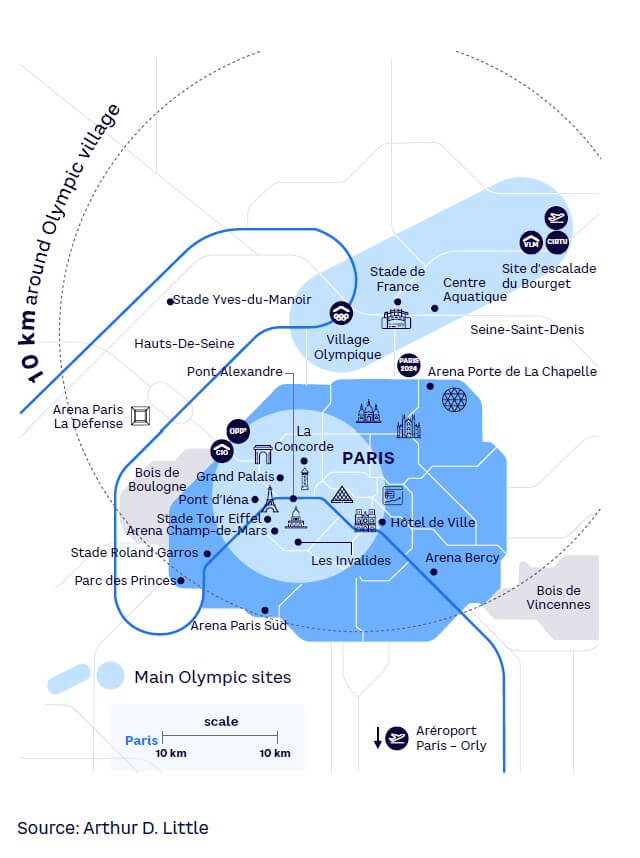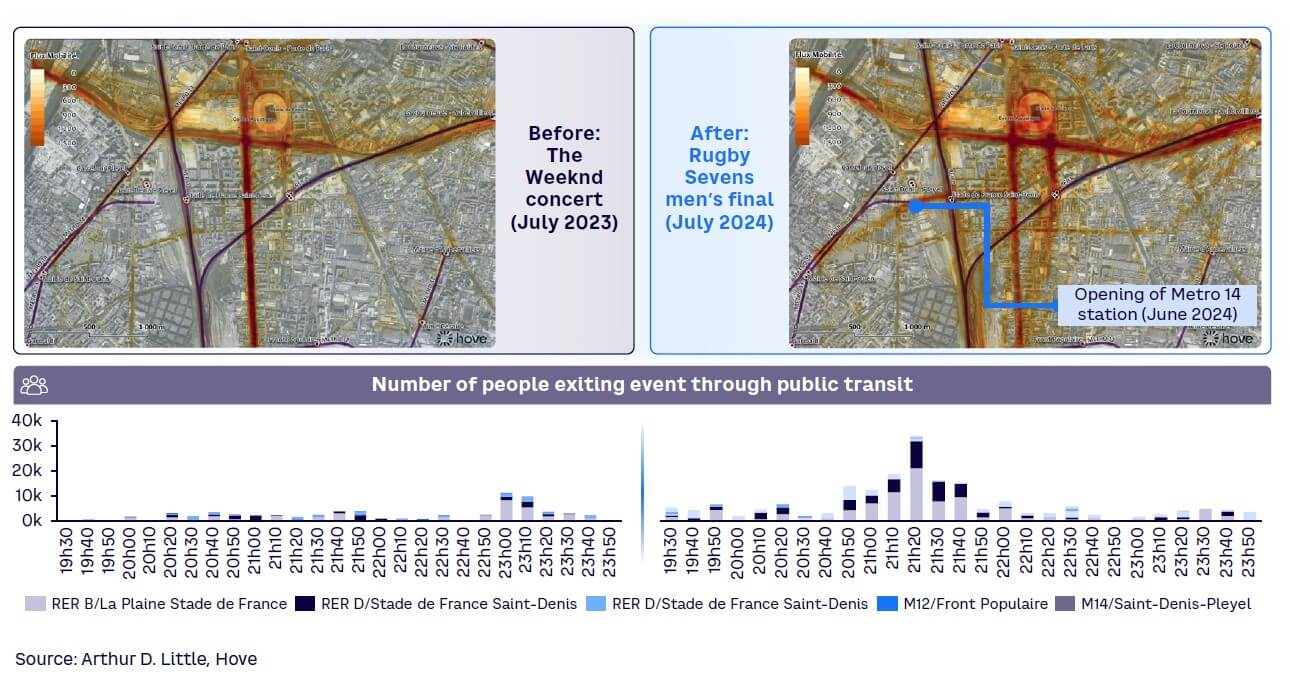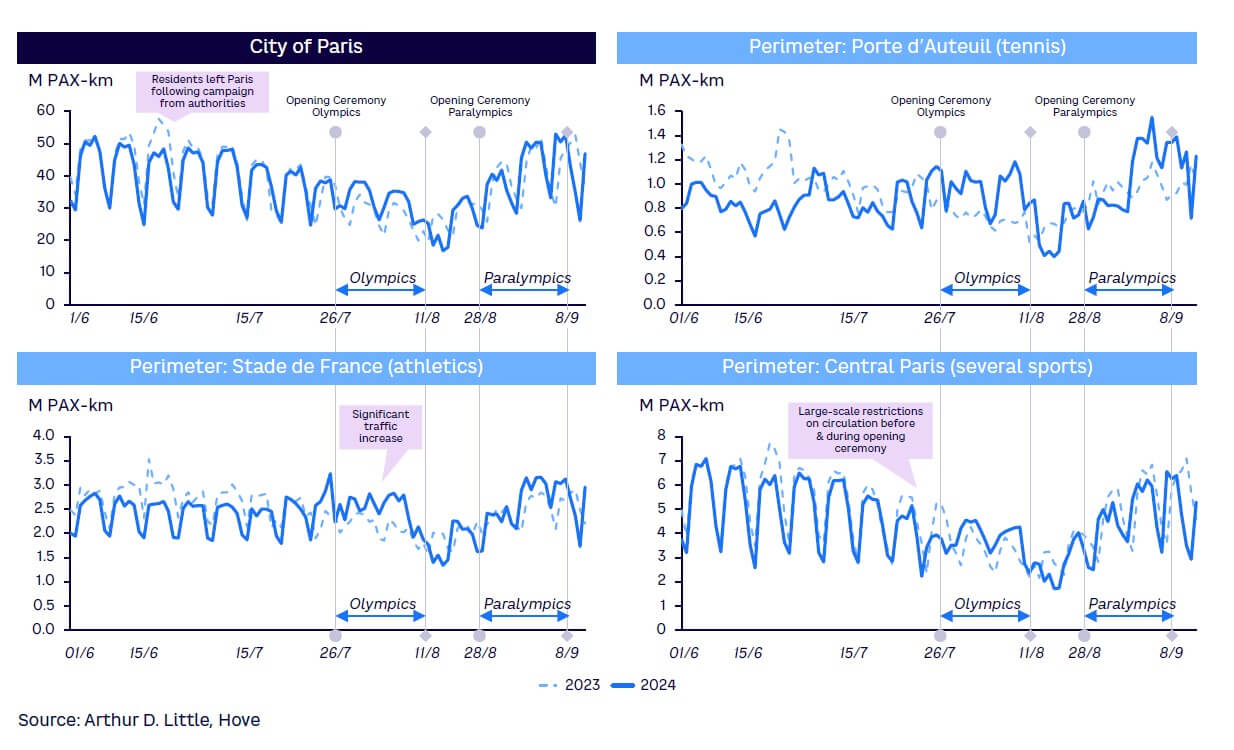
After the Paris 2024 Olympic and Paralympic Games ended in early September, the media, event organizers, and the International Olympic Committee (IOC) evaluated their success in terms of attendance, sports, security, and mobility. In this Viewpoint, Arthur D. Little (ADL) and Hove analyze how the Paris Games delivered on five key strategic items: governance, mobility supply, smart mobility, mobility demand management, and mobility funding to identify lessons to support mobility leaders engaged in organizing global events.
THE PLAYING FIELD: GAMES IN THE CITY
The Paris Games were organized across 39 event sites, concentrated in the city and its outlying areas (see Figure 1). The venues were organized into three zones:
- Central Paris — Eiffel Tower zone, Champs-de-Mars, Trocadéro, Place de la Concorde, and Les Invalides
- Western Paris — Roland Garros and Parc des Princes
- Northern Paris/Île-de-France — Porte de La Chapelle Arena, Stade de France, Le Bourget, and the Olympic Village in Saint-Denis

The Paris Games featured a high density of events located within a compact area, with the majority of spectators concentrated at venues within 15 km of each other. For instance, the distance between Stade de France and Porte de Versailles is only 12 km, with both conveniently connected by Line 12 of the Paris Métro. This aspect facilitated visitor mobility, making it easy and efficient for them to travel to their desired locations.
Participant and spectator figures were as follows:
- Athletes. Approximately 10,500 athletes competed in the Olympics and 4,400 in the Paralympics, similar to the numbers at the 2020 Tokyo Olympics.
- Delegations and staff. There were approximately two staff members and one delegation official per athlete, according to the Comité d’Organisaton des Jeux Olympiques de Paris (COJOP), the Paris Olympics organizing committee.
- Visitors. An estimated 11.2 million people attended, which included 9.5 million French nationals and 1.7 million international guests. This contrasts sharply with the Tokyo Games, which had no visitors due to COVID-19 restrictions, and Rio, which saw only half a million international attendees.
The IOC and COJOP set high ambitions for mobility, aiming to:
- Ensure fluidity of movement for all, with a focus on transporting athletes and delegations from the Olympic Village to competition sites.
- Guarantee a positive experience for all participants.
- Minimize environmental impact.
These aims were mapped against the five-dimensional framework we traditionally use at ADL to describe the key building blocks of a virtuous mobility system (see Figure 2), as described in a recent ADL/POLIS Report, “The Future of Mobility 5.0.” This Viewpoint serves as a concrete use case, assessing the effectiveness of how transportation was organized during the Olympics. To do this, we mapped the solutions used in Paris against ADL’s framework to assess how the mobility system effectively leveraged all five building blocks.

1. GOVERNANCE, POLICIES & VISION
Vision, preparation & organization
Operational governance preparations began early. COJOP was created on 18 January 2018, less than four months after Paris was designated as the host city. COJOP oversaw event management and temporary structures, including transport. SOLIDÉO, a public organization responsible for funding, was in charge of the Héritage program (permanent legacy infrastructures such as Porte de la Chapelle Arena, the Media Village, and the three Olympic Villages).
In 2022, COJOP started hiring in-house staff, which included:
- 1,000 full-time equivalent (FTE) hired by the end of 2022
- 2,000 FTE hired by the end of 2023
- 4,500 FTE hired during the Olympics
- 45,000 unpaid volunteers
Long before the Olympics, COJOP hired operators to run the Olympic buses for athletes and parathletes (including Keolis, Transdev, and Lacroix-Savac) through tenders and liaised with regular transport operators to develop a transport adaptation plan. At the operational level, public transport operator (PTO) RATP (urban transport) and SNCF (regional and national railways) anticipated impacts a year before:
- Changes to internal organization. Holidays, usually taken in August as transport demand is low that month, were spread out over several months to reduce traffic slightly.
- Regular maintenance work. This was accelerated to ensure almost all stations were fully ready and to anticipate a halt in maintenance work during the Games, which was accomplished by early closings for some stations in the months before.
- A mass transit plan. This was designed in coordination with COJOP and Île-de-France Mobilités (IDFM); this included event-specific special announcements and passenger information with Paris 2024 branding.
All stakeholders in a single room
In France, like in many countries, mobility responsibilities are typically spread across numerous entities with varying interests, funding, and timelines. However, for the Paris Olympics, a unified governance model was put in place, although it was a bit complex due to the number of stakeholders involved and the links between the different committees (according to Cour des Comptes, France’s supreme audit court, in 2023). Key actors involved:
- COJOP — responsible for overall coordination (all actors below were represented in the COJOP board)
- City of Paris — co-decision-making authority as the host city (with the French national government); responsible for urban management
- Préfecture de Police — represented the Ministry of Interior and oversaw security
- IDFM — regional public transport authority (PTA) that oversees transit for Paris and the surrounding areas
Collaboration among all stakeholders was crucial for successful mobility management. During the Paris Games, all stakeholders were coordinated at a system level for the first time, with an integrated view of all transport modes, including road infrastructure adaptations with dedicated lines and car-traffic restrictions. Even if governance was not a simple path, the other innovation of Paris 2024 was agility in governance models, as both “hard” and “soft” (unwritten) governance coexisted. Some day-to-day decisions were made in conjunction with RATP and Préfecture de Police and/or IDFM, which was not mandatory. Effective coordination and detailed planning were essential to meeting the complex needs of this event, and the outcomes could pave the way to integrated approaches in large urban areas even on a day-to-day basis.
2. MOBILITY SUPPLY
The Paris Games have spurred significant advancements in infrastructure and transportation offerings, showcasing a comprehensive approach to urban mobility and accessibility. Nevertheless, it should be noted that the city’s baseline transport infrastructure density was already top-notch. Major mobility service development and improvements were made in anticipation of the Games.
Public transit service-level improvements
- Increased frequency of train and metro services. To accommodate the influx of visitors and athletes, overall transport offerings grew by 15% compared to a typical summer, with a 23% increase in services on the Paris Réseau Express Régional (RER), comprised of five express train lines connecting the city center to the surrounding suburbs. Transilien, a commuter network with nine lines between Paris and the suburbs, added an additional 4,500 trains.
- Introduction of ephemeral and free bus lines. Ten new bus lines were introduced specifically for athletes and officials, effectively doubling public transport access to any Olympic site. Specific bus services for athletes were organized from Village Olympique to competition sites.
- Expansion of micromobility options. An additional 5,000 e-bikes from Lime were introduced, bringing the city’s total to 15,000. Three thousand new bike parking spaces were installed at train stations.
- Vélib Metropole expansion. The fleet of shared public bikes increased by 3,000, reaching a total of 20,000; 10 ephemeral stations were added.
Accelerated infrastructure improvements
Some infrastructure improvements were planned prior to Paris’s selection as the host city, but these plans were accelerated to accommodate the influx of visitors and participants:
- Metro line extensions. Line 11 was extended eastward, adding 6 km. Line 14 to Saint-Denis and Orly Airport added 14 km.
- Dedicated transportation lanes. A dedicated lane on the circular boulevard and key motorways (e.g., A1, A4, A13), totaling 185 km, was established for official transportation.
- New bicycle lanes. 120 km of new bicycle lanes were created, contributing to a total of 400 km designed for the Games.
- Additional civil works. A new bridge over the rail line at Saint-Denis was constructed to facilitate access from Stade de France area to the Saint-Denis-Pleyel Métro station.
HR & workforce management
- Workforce engagement. A significant workforce comprising 50,000 SNCF employees and 10,000 temporary workers, along with 35,000 of the 45,000 RATP agents, supported by 2,400 helpers, were engaged in operations.
- Social implications. Adjustments were made to holiday allocations, and drivers from subsidiaries in other cities were transferred.
- Employee incentives. Noteworthy social discussions led to specific bonuses for drivers and other transport agents.
Innovative initiatives
- Urban air mobility. An experimental project with Volocopter introduced eVTOL (electric vertical take-off and landing) aircraft. Operations were planned for two movements per hour between 8 am and 5 pm (17:00 Paris time) but never occurred due to regulation constraints (i.e., failure to obtain a homologation for a spare part on time). The new Vertiport installed at Quai d’Austerlitz to support these operations will likely never see any eVTOL in the future.
- Enhanced accessibility for parathletes. Toyota supplied new vehicles that were designated around the needs of parathletes, which enhanced accessibility and mobility.
The accessibility challenge
Despite these advancements, the Paris Games underscore ongoing challenges in metro accessibility for individuals with disabilities, highlighting the need for continued improvements in infrastructure inclusivity (see Figure 3).

Legacy
Expanding and adapting existing infrastructure is essential to meet the needs of any large-scale event like the Games. Significant investments in public transport can effectively reduce congestion and the carbon footprint, leaving room to increase or adapt the public transit infrastructure in most cities.
The legacy of some of the temporary infrastructure, such as the Paris 2024 reserved lanes, presents an opportunity for lasting improvements to urban mobility. This includes reducing congestion and emissions along key routes like the Boulevard Périphérique (where the speed limit was reduced to 50 km/h). However, only 3 km of dedicated bus lanes were created specifically for the event and remain as a legacy.
3. SMART MOBILITY
There is room to improve the flow of people using public transit through technology, such as by implementing dynamic journey planners. In the specific case of Paris 2024, the huge increase of traffic to its stations was managed by technology, mainly at ISO-capacity of existing infrastructure. The outcomes from the mobility strategies underline the high capabilities that could be unlocked through technology over the short term. When designed for a mass event, technology solutions could be an option to further analyze even for managing day-to-day peak hours.
Journey planning & flow management
Specific digital innovations featured a dedicated app launched by IDFM, which managed congestion by offering real-time transport updates powered by advanced algorithms:
- To regulate the flow of passengers and distribute them more evenly across different lines, the IDFM journey planner was modified to offer different trip combinations or options to users. A comparative approach to flow management in Stade de France in 2023 and 2024 (see Figure 4) demonstrated the large impact made by this new solution resulting from modifications to the PTA journey planner coupled with on the ground teams.
- Spreading people out across different transit options for almost all the Olympic sites (always presented as “best” and/or “fastest” in the app) and incorporating more walking distance lowered the congestion level at each station. Because walking speeds differ, greater walking distances to some stations meant that people tended to arrive at different times, further managing congestion.
Digital products helped significantly increase the modal share of public transit during a July 2023 performance by The Weeknd at Stade de France and the Paris Games and enhanced the capacity of existing infrastructure (up to 35,000 people at 9:20 pm [21h20 Paris time] in stations around Stade de France during the Games thanks to their capacity to spread the flow differently between the surrounding stations).

MaaS & distribution
The Paris Games highlighted major advances in both mobility as a service (MaaS) and ticketing systems to create a smooth transportation experience for attendees:
- The digitization of the customer journey, including real-time info, payment options, and ticket distribution, aimed to ease navigation through the city’s transport network using the latest technology across buses, metros, and trains.
- Ticketing was digitalized through Apple Wallet to allow foreign users to seamlessly use the metro network. There is no open payment method in the metro, so buying a physical ticket (or a virtual ticket through an app) was the only alternative.
- An enhanced tool, SNCF Connect AI, was integrated into internal SNCF devices to help personnel provide visitors with real-time translation support.
Fare policy
A special fare policy was designed for the Paris Olympics:
- A new daily fare of €16 was introduced, which was initially meant to be free for ticket holders. But the anticipated integration of sports tickets with public transport access failed to materialize, primarily due to technical challenges associated with the card-centric system and the absence of additional funding from COJOP.
- The regular metro and bus ticket price (€2) doubled to €4 during the Games to make visitors pay for transport. According to IDFM, the funds generated helped cover the extra expenses for public transport created by the Games.
- In mid-September 2024, IDFM announced a major simplification of its fare policies: one price for buses and trams and one price for heavy modes including the metro and suburban rails, regardless of distance. These changes are a by-product of the Olympic legacy.
4. MOBILITY DEMAND MANAGEMENT
During the 2024 Olympic Games, French authorities implemented a comprehensive demand management strategy to optimize the transportation network and expand capacity for the influx of visitors. The coordination of local residents’ movements was central to this plan, significantly reducing daily commuting and vehicular flow within the city. Parisian authorities introduced restrictions around key Olympic sites, added limited driving and walking zones, and established low-traffic zones (LTZ) in central Paris. The overall objective was to redirect the city’s transportation resources to serve international visitors, ensuring minimal disruptions to Olympic events and easing pressure on the public transit system.
During the months of June 2024 and July 2024, a campaign from French authorities encouraged workers to avoid commuting by working from home. The average traffic (all modes, including walking) in passenger-kilometer (PAX-km) in Paris fell by 5% (40 million versus 42 million in 2023). The restrictions of movement in Paris during the day the Opening Ceremony was conducted on the Seine led to 20% less traffic, according to our research. But the degree of restrictions was remarkably high, led to widespread criticism,[1] and could not be reproduced on a like-for-like basis in the long run (see Figure 5).

Furthermore, authorities leveraged the natural seasonal decline in traffic, as the period of the Games coincided with a slowdown in economic and commuting activities. This organic reduction in local transportation demand (in Summer 2023, according to data analysis from Hove, car traffic fell by 35% and public transport usage dropped by 60% during this period in Central Paris compared to June 2023), coupled with targeted interventions, allowed for smoother mobility management.
In Paris, cumulative distances traveled increased by about 19% during the Olympic period compared to a regular summer (33.1 million daily PAX-km during the Paris 2024 Olympics versus 27.9 million in the same period of 2023), which remained much lower than an average month of June (approximately 46 million daily PAX-km). The return to normal occurred quickly after the end of the Games: during the Paralympics game period — which overlapped the return to work in September — there was only 0.9% more traffic compared to 2023 (41.2 million daily PAX-km in 2024 versus 40.9 million daily PAX-km in 2023).
Demand management strategies minimized congestion and also freed up the city’s transport network to better accommodate Olympic visitors. By anticipating these changes, the city ensured efficient transport capacity while maintaining a balance between the needs of residents and international guests.
This proves that mobility demand management, through implementation of the right mix of smart measures (defined on a case-by-case basis) constitutes a strong component of any mobility strategy, and that the PTA should use these solutions. Paris illustrates a large-scale example of how restrictions made some car traffic disappear (“evaporation”), shifted some to other modes, or simply reduced traveling by modifying trip length or avoiding unnecessary trips. Not all car trips should shift to sustainable mobility; some trips could better be restricted in extremely specific use cases.
5. MOBILITY FUNDING
Mobility funding, already a major concern, becomes even more complex when preparing for large events. Public transit networks are funded through a mix of sources from overlapping groups of users (approximately 30%-40%) and taxpayers (approximately 60%-70%), as well as users who visit and do not pay local taxes and require:
- Additional capabilities and infrastructure to host a large event — which will remain a landmark for local residents
- Additional operational funds to meet increased service needs — mainly to serve nonresident users
PTAs should determine how to price services to ensure that visitor revenue makes a fair contribution. Requests could be made of taxpayers and residents around higher payments, as fixed infrastructures will help address mobility issues for residents. But to expand service levels, nonresident contributions could be collected through special fares (e.g., airport tickets, temporary price increases during large events) and special taxes (e.g., airplane ticket taxes, hotel tourist taxes).
An additional budget of €250 million (~US $270 million) was allocated and released to support transportation infrastructure for the Paris Olympics, mainly to fund IDFM’s request to operators for increased service levels. This funding was provided by IDFM by raising the price of a metro and bus ticket to €4 temporarily during the 2024 Games and lowering it back to €2 after the event. The aim was to make mobility options for the Olympics financially self-sustaining without burdening the transportation budgets of local residents during the rest of the year. Contrary to initial promises, ticket holders attending the Games did not receive free access to public transport. The absence of a financial agreement between COJOP and IDFM prevented such an arrangement from being implemented.
KEY TAKEAWAYS
PTAs, PTOs, and other mobility services providers that want to shape the future of urban mobility must prepare to tackle four critical challenges:
- Compliance. Environmental and social regulations are becoming increasingly stringent.
- Image management. Transportation performance during high-profile events directly impacts public perception.
- Legacy. Infrastructure and services should be maintained for the ongoing benefit of residents long after the events conclude.
- Innovation. Advanced technology and seamless mobility solutions are needed to meet the demands of both event participants and daily users.
The following five pillars can address these challenges:
- Governance. Effective governance is critical to the success of events like the Paris Games. While written rules ensure compliance, a more flexible, project-based approach, driven by soft rules and shared goals, proved effective during the 2024 Olympics.
- Mobility supply. Expanding transport capacity during an event is essential, but it should also contribute to long-term improvements. Leveraging existing infrastructure is often necessary, as large-scale projects face time and cost constraints (e.g., Paris Métro accessibility upgrades were not completed in time).
- Smart mobility. Smart mobility solutions, particularly based on MaaS and app technology, are vital for managing crowds by staggering travel times and preventing congestion. Innovative approaches based on these solutions were successfully implemented at venues like Stade de France and Porte de Versailles.
- Demand management. Managing operations effectively ensures smooth operations during high-traffic events and promotes lasting mobility changes. The sharp reduction in car use in Paris during the Games illustrated this; the measures introduced remain in place on the Boulevard Périphérique, the ring road in Paris, and positive long-term impacts are expected.
- Funding. A balanced contribution from passengers is essential to sustaining public transport services. Pricing strategies tailored specifically for visitors, along with targeted taxes, can contribute to generating the necessary event funding (e.g., Paris doubled tariffs during the Games).
Conclusion
GLOBAL EVENTS ARE SPRINGBOARD TO FUTURE OF MOBILITY
The Paris 2024 Olympic Games undoubtedly showcased remarkable achievements in transportation and mobility, setting new standards in large-scale event management. The meticulous planning and unprecedented collaboration among stakeholders resulted in a largely successful mobility strategy.
Looking forward, sustainable mobility will no longer be a differentiator but rather a prerequisite for major international events. This is illustrated by the upcoming Los Angeles 2028 Olympic Games, which are already raising the bar for environmental and social standards. Similarly, the 2030 FIFA World Cup is expected to follow suit, making it clear that future hosts will need to demonstrate their commitment to sustainable and efficient mobility solutions. The legacy of the Paris Games must therefore serve as a benchmark; it will also need to evolve in the face of even higher expectations.
Note
[1] Restrictions included a large “no-go” zone in central Paris where people (even residents and their friends) were not allowed to enter without a permit issued by a government website (issuance of these permits could be refused if the applicant failed to pass security screenings). All permits were checked when entering the zone by scanning a QR code.




